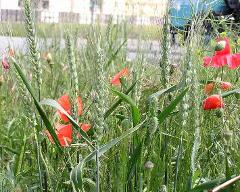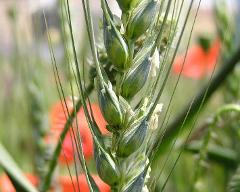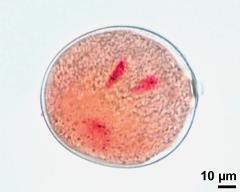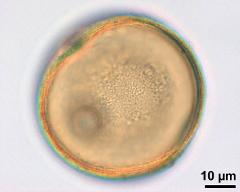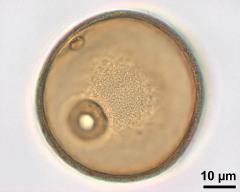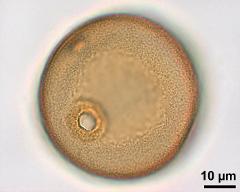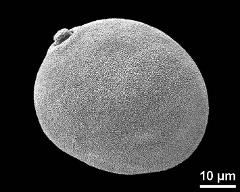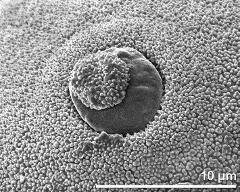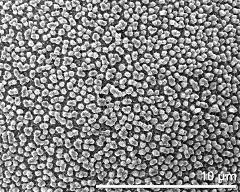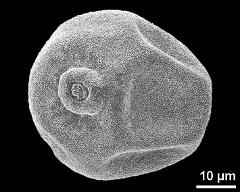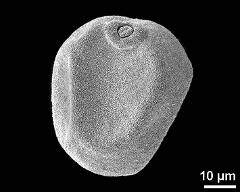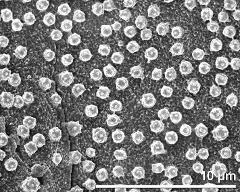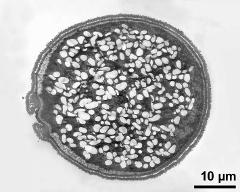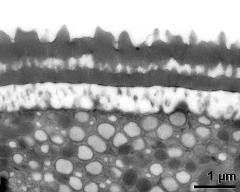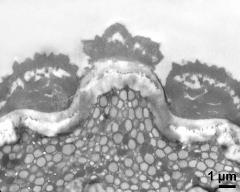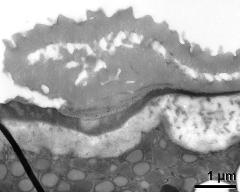Triticum aestivum
Taxonomy: Angiospermae, Poales, Poaceae, Triticum
Published: 2016-07-13
Pollen Description
Shape, Size and Aperture
pollen unit: monad, dispersal unit and peculiarities: monad, size (pollen unit): large (51-100 µm), size of hydrated pollen (LM): -, shortest polar axis in equatorial view (LM): -, longest polar axis in equatorial view (LM): -, shortest diameter in equatorial or polar view (LM): -, longest diameter in equatorial or polar view (LM): -, pollen class: ulcerate, polarity: heteropolar, P/E-ratio: prolate, shape: -, outline in polar view: circular, dominant orientation (LM): -, P/E-ratio (dry pollen): prolate, shape (dry pollen): -, outline in polar view (dry pollen): irregular, infoldings (dry pollen): interapertural area sunken, aperture number: 1, aperture type: ulcus, aperture condition: ulcerate, aperture peculiarities: operculum, annulus
Ornamentation and Structure
LM ornamentation LM: scabrate, nexine: -, sexine: -, SEM ornamentation SEM: microechinate, suprasculpture SEM: -, TEM tectum: eutectate, infratectum: columellate, foot layer: continuous, endexine: absent, intine: monolayered, wall peculiarities: -, supratectal element: -
Miscellaneous
pollen coatings: absent, reserves in cytoplasm: polysaccharide vesicles, starch, cell number: 3-celled, Ubisch bodies: present
Author(s) of diagnosis: Diethart, Bernadette
Pictures
Picture legend
- habitus, photographer: Diethart, B.
- flower(s), photographer: Diethart, B.
- pollen grain with vegetative nucleus and two sperm cells - fresh, unfixed, aceto-carmine, photographer: Diethart, B.
- upper focus - fresh, acetolyzed, unstained, photographer: Diethart, B.
- optical section - fresh, acetolyzed, unstained, photographer: Diethart, B.
- lower focus - fresh, acetolyzed, unstained, photographer: Diethart, B.
- equatorial view - fresh, rehydrated (water) & critical point dried & sputter coated with gold, photographer: Diethart, B.
- aperture - fresh, rehydrated (water) & critical point dried & sputter coated with gold, photographer: Diethart, B.
- exine surface - fresh, rehydrated (water) & critical point dried & sputter coated with gold, photographer: Diethart, B.
- polar view (dry pollen grain) - dry, sputter coated with gold, photographer: Diethart, B.
- dry pollen grain in equatorial view - dry, sputter coated with gold, photographer: Diethart, B.
- anther wall with Ubisch bodies - fresh, rehydrated (water) & critical point dried & sputter coated with gold, photographer: Diethart, B.
- pollen grain in cross section - fresh, glutaraldehyde & osmium & potassium ferrocyanide, uranyl acetate & lead citrate, photographer: Diethart, B.
- interapertural area of pollen wall - fresh, glutaraldehyde & osmium & potassium ferrocyanide, uranyl acetate & lead citrate, photographer: Diethart, B.
- apertural area of pollen wall - fresh, glutaraldehyde & osmium & potassium ferrocyanide, modified Thiéry-test, photographer: Diethart, B.
- pollen wall at transition of aperture and interapertural area - fresh, glutaraldehyde & osmium & potassium ferrocyanide, uranyl acetate & lead citrate, photographer: Diethart, B.
Literature
- (1994) Exkursionsflora von Österreich : 1180
- (1998) Preparing living pollen material for scanning electron microscopy using 2,2-dimethoxypropane (DMP) and criticalpoint drying. Biotechnic Histochem 73: 137–143
Copyright and Citation
Cite this publication as:
Diethart B. 2016. Triticum aestivum. In: PalDat - A palynological database. https://www.paldat.org/pub/Triticum_aestivum/301222;jsessionid=668AEB2DC8B8F6DA4A466FCB18F4BF07; accessed 2025-11-01

